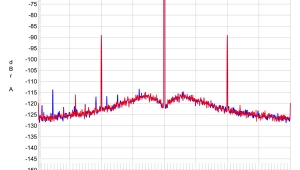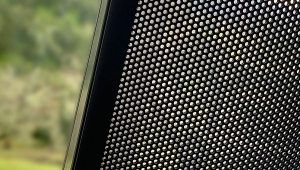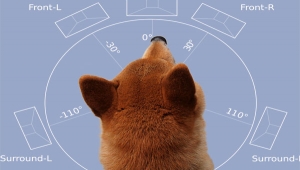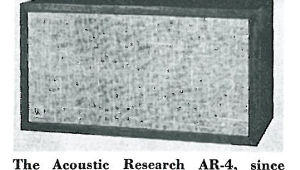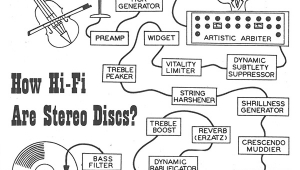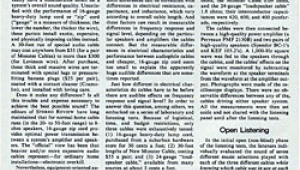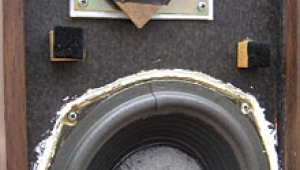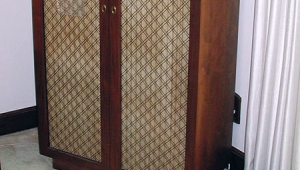| Columns Retired Columns & Blogs |
Watkins WE-1 loudspeaker JGH Returns
Gordon Holt returned to the Watkins in January 1984 (Vol.7 No.1):
Footnote 1: Watkins Engineering had been OEMing loudspeakers for other high-end manufacturers (like Infinity) for some years, but the WE-1 was the firm's first consumer product.
The more these speakers stay around my listening room, the more I like them. Their flaws—the ill-defined deep bass and the slightly laid-back quality—are easily excused in view of the sheer musical pleasure they provide, and their "slightly soft" high end seems to be just right for the best CDs (Telarcs, M&K Digital Masterpiece series, to date), producing an amazingly convincing representation of the sweet but detailed high end in live musical sound. I find that these speakers "wear" better than any I have lived with for many years.
Anyone about to spend $3000 for a pair of speakers owes themselves a listen to these large but musical (and largely unheard of) speakers.—J. Gordon Holt
He again wrote about the Watkins in October 1984 (Vol.7 No.6):
Bill Watkins will be furious when he reads this, but I'm vacillating about the modifications he's made to the WE-1.
In my initial report (Vol.6 No.5), I complained about an overall lack of detail and snap from this system. Bill made some minor modifications, which I then tried; I agreed with him that they dramatically improved detail and snap. Now, having alternated between the two versions for some weeks, I must conclude that I prefer the original, less detailed, less "snappy" sound for most of my listening. It's a personal thing, actually. Very little program material is clean enough to stand up to close scrutiny, and material that does is almost always musically uninspired. When I listen to music for enjoyment, I rarely choose performances that are on audiophile-quality discs. Therefore I prefer to listen to them through a system that has a little less than the ultimate detail.
My final suggestion for the Watkins speakers: Install a switch on the back to allow selection of musical (original) or analytical (modified) sound. I'm not asking Watkins to do this; I've given him enough hassle as it is. I'm suggesting that the WE-1 owner (or a friend competent with a soldering iron) do the modification. For wiring instructions write to Watkins Engineering.
I have not, however, changed my feeling about this speaker. Imperfections or no, when paired with the Electron Kinetics Eagle 7A amplifier (especially the latest version) it produces some of the most listenable, musical sound I've heard from any amp1ifier-speaker combination.—J. Gordon Holt
Gordon Holt wrote about the Watkins WE-1 Series II in November 1986 (Vol.9 No.7):
Many solstices ago, in Vol.6 No.5, I reviewed at some length a loudspeaker system, which subsequently became one of my most durable favorites. It was the Model WE-1 from a then-new company called Watkins Engineering (footnote 1), and it sold (at the time) for $2990/pair.
An all-dynamic system, the WE-1 was (and still is) bulky and not exactly modestly priced, but its strongest points were its remarkable musicality and listenability. Imaging and soundstaging were merely very good, bass (with solid-state amplifiers, with which it did best) was impressively deep with very good impact, but was described in that report as "oddly undifferentiated, as though the bass is all being generated by the same kind of (unidentifiable) instrument." The report also noted a mild middle-range deficiency—a common failing in audiophile speakers, for which I was just then (June 1983) beginning to develop an acute intolerance.
Generally, the report was favorable, but I could not at the time have predicted how much more I would come to like the WE-1 with prolonged listening and the use of better power amplifiers. (Those subsequent developments were duly reported as "Follow-Up" items in Vol.7 Nos.1 and 5.)
My original report on the WE-1 was the first published anywhere, and, according to company prexy Bill Watkins, was instrumental in getting the company off the ground. From time to time after its publication, Bill had been sending me Xeroxes of warranty cards from customers, with comments indicating great satisfaction with their WE-1s, so I was a little surprised to learn that in the interim Bill had continued to refine the speaker, and had eventually changed the model designation to WE-1 Series II.
The Series II is indistinguishable in appearance from the original model, except for some differences in the crossover network configuration which you would never spot without a direct comparison. (The crossover is set into the rear, directly beneath the connection panel, and is visible without dismantling anything.) Fortunately, both the factory packing carton and the rear connection panel are clearly marked "Series II," so there's no possibility of confusing a Late with an Early model.
The audible differences between the original WE-1 and the Series II are small but significant: all the areas where the original model had slight but definite weaknesses have been improved. Bass is tighter and has better definition, being now a little better than average (for this price class) in detail instead of a little worse. The midrange is now much better than most, resulting in a greater feeling of dynamic impact and range. Highs are very slightly sweeter, and at the same time more extended, and, for reasons I cannot explain (they may even relate to my improved listening room), the system reproduces depth and spaciousness much better than before.
Above all, the system retains the uncanny listenability and musicality of its predecessors. In other words, the Series II WE-1 has gained in many areas and yielded in none. Incredibly, even the price remains unchanged. (Watkins has few dealers, preferring to market factory-direct, with a 10-day in-home trial and full refund if unhappy.)
Unfortunately, there has been little improvement in the overall clarity and transparency of the WE-1, and these are areas where tremendous strides have been made by other, newer loudspeaker designs. The current crop of planar (including curved) loudspeakers have given new meaning to these terms, setting standards that no conventional dynamic (cone-and-voice-coil) systems, including the WE-1 Series II, have been able to equal (although some come closer than the Watkins). By comparison with this new breed, the WE-1 II sounds rather veiled.
Most of the others are costlier than the WE-1 II, and very few can approach the Watkins's seductive richness and body, to say nothing of its remarkable LF range and power capability. But there are a few—the MartinLogan CLS, for one—which combine superb musicality with that remarkable detailing and hear-through quality that typifies the new breed of planar speakers, at a price directly competitive with that of the WE-1 II. (In fact, the CLS is about $500 cheaper.)
Thus, I cannot consider the Watkins to be a hands-down winner in its price class, because of those areas in which it is clobbered by pricewise competition. But when I consider the demands put on the cleanness of the associated components by the remarkable lucidity of a planar system—some full-range ribbons demand immense current capability of the power amp as well—and the Watkins's slightly more forgiving qualities, I cannot count it out of the running.
There are other dynamic systems of comparable price which image and reproduce depth better, and sound more pristine and transparent than the WE-1 II (the $1950/pair Thiel CS3, for example). But there are few whose overall spectral balance and accuracy in reproducing musical timbres equal that of the Watkins, and those are qualities which I value very highly. So I must, once again, draw a distinction between the music lover and the audiophile when I say that the WE-1 II is more a music-lover's system than an audiophile's.
Given my druthers, I would still rather live with a pair of WE-1 Series II Watkinses than any other comparably-priced cone-type system I have heard. But throwing in the available comparably-priced planar-type systems for consideration—Apogee Scintilla and Duetta, Magneplanar MG-III, Quad ESL-63 and MartinLogan CLS—would make the buying choice much more difficult; while I love their superior transparency, I am much less enamored of their low-end performance. All I will say, therefore, is that, as of now, the WE-1 II is one of my four reference speakers (footnote 2), none of which is unequivocally better than any other on a price/performance basis. How's that for a cop-out?—J. Gordon Holt
Footnote 1: Watkins Engineering had been OEMing loudspeakers for other high-end manufacturers (like Infinity) for some years, but the WE-1 was the firm's first consumer product.
Footnote 2: The others? The Infinity RS-1B, Sound Lab A-3, and MartinLogan Monolith.
- Log in or register to post comments

